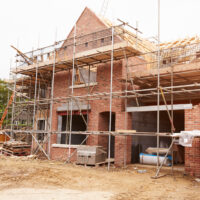
Around 31% of brokers say they are seeing more new-build incentives from housebuilders, a poll has found.
According to a Mortgage Solutions poll, around 46% said they weren’t seeing more new-build incentives and 23% were seeing fewer incentives.
Developers can offer new-build incentives to entice buyers such as part exchange deals where they buy your home and sell it on themselves, lower deposit mortgage options form the likes of Own New, paying the deposit, stamp duty and other costs.
John Phillips, CEO of Just Mortgages and Spicerhaart, said while nearly a third had reported more incentives being offered by housebuilders it was “important to clarify what these ‘incentives’ actually entail”.
He continued: “In our experience, I wouldn’t categorise many of the current offers as traditional incentives. Unlike the past, we’re not seeing the usual perks such as free carpets, mortgage payments, or other complementary extras that typically sweeten a deal.
“Instead, what’s really standing out is the significant increase in part exchange options. This shift is quite unusual compared to a year ago. Back then, housebuilders were far less willing to entertain part exchange deals, especially in a buoyant market where properties were selling quickly. However, this has changed dramatically.”
He said the rise in part exchange deals showed housebuilders were “more motivated to move their properties, even if it means taking on the complexities of a part exchange”.
“This is a significant development, as it suggests a subtle shift in the market dynamics where builders are adopting more aggressive strategies to ensure sales, reflecting a possible softening in demand or a build-up of unsold stock.
“From our vantage point at Just Mortgages, this aligns with the broader trend of builders looking to keep transactions flowing amid a more challenging economic environment. It’s not about flashy incentives but about practical solutions like part exchange, which offer real value to buyers who might be struggling to sell their own properties in a slower market,” Phillips explained.
Noord Romjon, director at New Homes Mortgage Broker, said it was hearing more hearing more incentives being offered to purchasers in the current climate.
He said: “As we know developers are reluctant to accept price reductions as this can affect valuations on future sales, so builder incentives are a way to attract buyers. We are also finding that buyers have an expectation of a deal especially if they have viewed different developments.
“This of course does depend on the development and you are more likely to receive an incentive on a stock plot than you are from buying off-plan.”
New build incentives play ‘important role’ in FTB market
Paul McCarthy, head of new build at Santander UK, said developer incentives had played an “important role in the first-time buyer market” for years.
“We know that the market is dynamic and the results of this poll, with around a third of brokers reporting more developer incentives on the market, reinforce this.
“With house prices at historical highs, it’s more important than ever that brokers have a comprehensive understanding of both the support being offered by developers, as well as lenders’ policies, to enable more first-time buyers to realise their dreams of home ownership,” he said.
McCarthy said the lender often saw developer incentives factored into brokers’ cases, which not only supported first-time buyer purchases, but helped ensure their first home was a more energy efficient one.
He continued that it offered 95% loan to value (LTV) mortgages on flats and houses and offered a range of support for brokers with first-time buyer clients, with cash incentives.
“We allow cashback of up to 5% plus reasonable legal fees and stamp duty, for LTVs of 90% and under as well as non-cash incentives. For LTVs over 90% we support with non-cash incentives, as well as allowing stamp duty and legal fees to be covered, and for homemovers we allow for their estate agency fees to be paid also.
“For first-time buyers to realise the benefit of developer incentives, broker experience and expertise remains absolutely critical,” he added.
‘Free extras and incentives are just masking high asking prices’
Paula Higgins, chief executive of HomeOwners Alliance, said consumers really wanted to know the timings of the new-build incentives to negotiate the price of a property.
She continued that developers tend to offer incentives off-plan, at year-end and at the last plot or two.
Higgins said housebuilders like to sell off-plan before properties are built as it is a “cash intensive business so it’s good for their bottom line if they can sell more this way”.
She continued that at year-end, housebuilders were under pressure to meet sale targets and if there were only a few properties the housebuilder would be “keen to get off site and move all resources to their next project”.
Higgins said that in late 2023, Barratt, the UK’s largest housebuilder, said its incentives were running at 5%-6% of the house price versus 1%-2% the previous year, while Persimmon noted that it was using incentives at around 3.2% per plot.
“The more popular incentives include getting stamp duty paid and free upgrades such as higher quality kitchen units, with better branded white goods and higher quality flooring.
“We’ve also heard of developers offering a free Tesla, thousands of pounds towards a holiday, free car parking space, annual travel card and cash contributions to the deposit,” she added.
Higgins said “free extras and incentives are just masking high asking prices”.
“Brokers will know that incentives offered by the developer over about 5% of the value of the property may impact how much the mortgage provider will lend. So, we always advise to speak to a mortgage broker about any incentives agreed as early as possible,” she explained.
Lenders offering higher LTVs for new build but more support needed
David O’Leary, executive director of Home Builders Federation, said in the last few years builders have had to “work hard to convert the undeniable interest in new, energy efficient homes into mortgage-ready buyers”.
“Soaring interest rates from the end of 2022 coincided with the closure of Help to Buy, a scheme that had supported a third of a million first-time buyers onto the housing ladder in new build homes during the preceding decade.
“Rising deposit requirements and stretched affordability, particularly for first-time buyers has necessitated innovation as builders have sought to offer some support in the void left by the absence of government assistance,” he said.
O’Leary pointed to the rate reducer deal from Own New has “seen incentives repackaged to subsidise mortgage rates, for instance, but there is inevitably a limit to what can be achieved without greater support from lenders or government”.
“Uncertainty in the sales market and a lack of industry confidence over the ability to turn latent demand into effective demand for new homes continues to hold back investment has been one of the primary reasons for the downturn in housing supply seen in recent times.
“Indeed, amidst a cost-of-living crisis, with higher interest rates and with house prices significantly out of kilter with median incomes, it is striking that this is the first sustained period in more than 60 years with no effective homeownership support from the government. During the 20th Century that assistance typically took the form of mortgage interest reliefs while the 2000-2022 period saw initiatives aimed at helping buyers acquire new homes through shared equity products, equity loans or specialist guarantee programmes,” he said.
O’Leary said there had been “encouraging signs in recent months” with mortgage lenders raising their maximum loan-to-values on new build houses, and to some extent on flats too.
“Greater lender support for new build purchasers through higher LTVs and – crucially – integration of genuine green mortgage products – would help to engender greater confidence and will ultimately lead to more first-time buyers realising the dream of homeownership,” he concluded.
Anna is currently the deputy editor for Mortgage Solutions and editor for Specialist Lending Solutions. She has worked as a journalist since 2019, having secured her Gold Standard NCTJ diploma from News Associates in a fast-track six-month course.
She started her career as a report at specialist publication The Insurance Insider covering a wide range of areas before joining Mortgage Solutions and Specialist Lending Solutions in 2021.
In her role, she helps put together and structure the news agenda for the day and writes up press releases, reports, interviews, analyses and exclusives across both titles. She also commissions blogs for Specialist Lending Solutions and hosts online masterclasses and in-person events across the business.
She has been shortlisted for three journalism awards, which include BIBA Journalist and Media Awards Scoop of Year Award in 2020, Headline Money Mortgage Journalist of the Year Award (B2B) in 2022 and 2023.
Prior to being a journalist, Anna worked in ecommerce across Snow + Rock, Cycle Surgery and Runners Need websites, and before that worked at specialist financial PR firm Rostrum.
In her spare time, Anna enjoys reading, seeing live music, and cooking for friends and family. When she gets a chance, she also enjoys hiking, skiing and indoor rock climbing.



